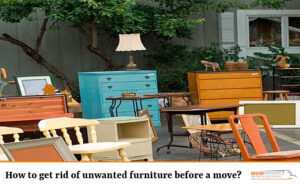
How to Pack Your Garage: The majority of us wait until the last minute to stuff our garage. After all, who wants to deal with the large, difficult-to-pack goods lurking in its corners, such as rakes and golf clubs? Or the ones that could be dangerous, such as pruning shears? Furthermore, dangerous products such as paint thinner, insecticides, and pool chemicals are frequently found in garages and must be appropriately disposed of.
Taking care of the garage early in the process, on the other hand, can make the remainder of your move go more smoothly. Here’s why you should start with the garage, as well as some packing advice.
Moving Soon?
Here are the best moving companies you can trust;
Xfinity Moving
College Hunk
Two Men and a Truck
All My Sons Moving and Storage
U-Haul
College Hunk
Portable On Demands
Budget Truck Rental
1-800-PACK-RAT
Penske
Best Interstate Moving + Storage
Go to the garage before you start boxing things up in the guest room or forming a Thrift store mound in the middle of the living room. The garage will likely require more time and work to pack because it is one of the largest and least structured spaces in your home. You’ll be fatigued and unprepared to meet the challenges if you wait until the final few days before your move to start packing.
Starting with the garage allows you to set up a staging area for the remainder of the house’s packing. Moving packing materials from room to room is no longer necessary. With an already crammed garage, you can set up a folding table with materials nearby and make heaps of goods to donate, sell, or toss out. Having a staging area in the garage helps to keep the chaos of moving out of the house to a minimum.
For the garage, you’ll need the same basic packing supplies as for the rest of the house. Because many of the goods in the garage are heavy and irregularly shaped, you may want to acquire a few specialty boxes as well as durable cardboard or plastic moving boxes for the job.
You’ll also need a lot of material to wrap sharp or breakable objects. Because objects stored in the garage can be unclean, oily, or contain chemicals, old towels and blankets are great. If you don’t have enough, Goodwill is a good place to look for inexpensive towels and blankets. Also, don’t skimp on packaging tape. Heavy boxes should be double and triple-sealed. You’ll need the following items:
Begin by dividing your garage into two sections, one for stuff you want to give and the other for stuff you want to sell. Then grab a trash bag and start working on one portion of your garage at a time. Throw damaged goods and rubbish in your garbage bag as you go, and donate or sell items in the proper categories.
Instead of thinking that whatever box you come across is ready to use, take the time to open it. It’s possible that you don’t need or desire the objects inside, or that they’re no longer usable. Rubber and plastic parts, for example, might become brittle and fractured over time. Anything you can get rid of now will save you time packing and unpacking afterward.
Deal with your heaps of goods to donate and sell as they grow so they don’t overwhelm you. You can donate stuff to Charity. You can advertise your stuff for sale online if you want to. You can also save the stuff for a pre-move thrift store.
If you’re planning a garage sale, get an early start by cleaning and price-tagging each item in the sell pile. After that, set aside a space for your garage sale things. If you’re going to store these items in boxes until the sale, make sure they’re properly marked as such and kept separate from the filled boxes you’ll be moving.
You’ll almost probably come across goods that aren’t permitted on moving trucks or storage while you declutter. Before you begin sorting and packing, spend a few minutes familiarizing yourself with the goods that your moving company does not allow. When you come upon an item that isn’t authorized, put it aside to dispose of later or transfer it by automobile if you’re going to your new residence.
Begin grouping comparable objects together once you’ve finished decluttering. To avoid injuries, wrap anything with sharp edges, such as shears or spades, in old towels or bubble wrap. Place these things, as well as any other hand tools, in a sturdy cardboard or plastic box. If you’re utilizing cardboard boxes, make sure the bottoms are tightly taped numerous times to avoid overcrowding.
Pack your power tools in their original packaging or carrying containers whenever possible. Strong cardboard or plastic box will suffice if not. Remove all detachable pieces, including the battery pack, and wrap the cable around their bodies before packing power tools. To avoid damage, wrap the box with bubble wrap or old towels, and fill any empty places with wadded packing paper for maximum safety.
Carry on with the items in your garage that are oddly shaped. Gardening and lawn equipment with long handles, such as rakes, brooms, and shovels, can be rolled in a moving blanket and tied together with string. Although sports equipment may require special crates, many odd-shaped objects, such as bicycles, can be placed directly into the truck. Even the lawnmower can be loaded once the gas and oil have been drained and the spark plug has been unplugged.
Set aside tools you’ll need for packing other sections of your home and unloading them at your new home as you pack the garage. Many of the needed things may be found in a small toolkit, but if you don’t have one, you’ll want to make your own using the list below as a reference. There are also some more essentials on the list that you should have on hand.
Related Articles:





